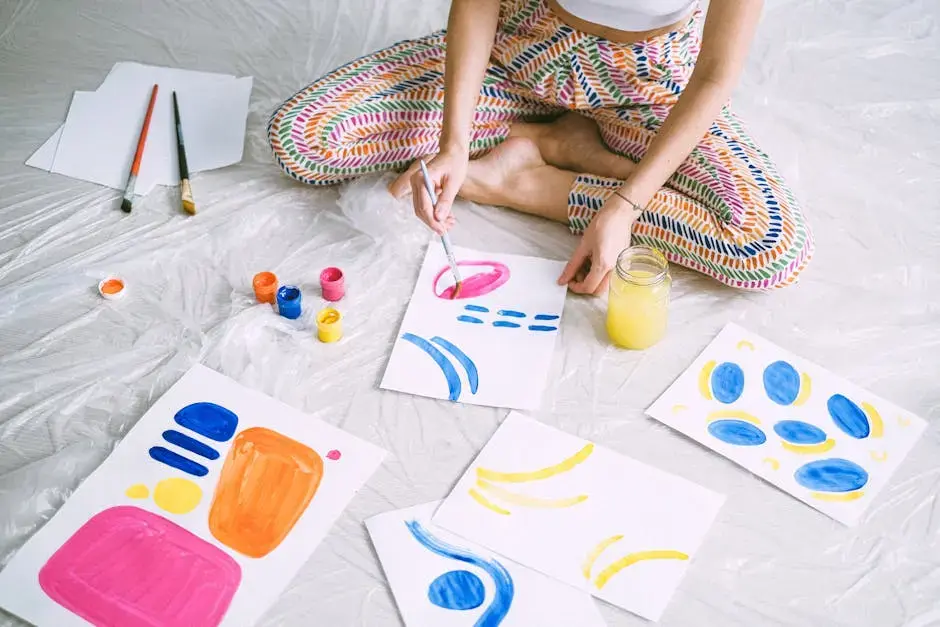10 Creative Therapy Techniques to Enhance Emotional Well-being
- Karrie Stafford

- Feb 21
- 6 min read
In today's fast-paced world, prioritizing our emotional health is more important than ever. Creative therapy techniques can help us express our feelings, explore our thoughts, and alleviate stress. Whether you're seeking to understand your emotions better or just looking for a new hobby, these approaches can be both effective and enjoyable. Let's dive into some creative therapy techniques that can transform your emotional wellbeing.

1. Art Therapy: Expressing Through Visuals
Art therapy allows individuals to create and express their emotions through various art forms, helping to release feelings that are often difficult to verbalize.
By using tools like paints, clay, or even digital mediums, participants can engage in a personal exploration of their thoughts and emotions. This technique isn’t just about creating art; it’s about the process of making and the insights gained along the way. The beauty of art therapy is that you don't need to be a skilled artist to benefit. The act of creation itself can serve as a powerful therapy, allowing feelings to come to the surface in a meaningful way.
Moreover, when individuals create visual representations of their thoughts, they often gain new perspectives on those feelings. Art can facilitate conversation about difficult subjects, helping people to communicate in ways they might not have been able to otherwise. Whether you're doodling your thoughts or crafting detailed projects, the key is to allow your emotions to flow freely through your hands.
2. Music Therapy: Healing with Sound
Using music to explore emotions can be incredibly powerful. Whether it's listening to your favorite songs or creating music, this therapy can evoke feelings and memories.
Music therapy can be as simple as putting on headphones and immersing yourself in soothing melodies or can involve a more interactive process, such as composing. This unique approach taps into the brain’s connection with sound and rhythm, which can help release tension and foster a sense of peace. Music has a remarkable ability to resonate with our emotions; a single note or lyric can bring memories rushing back, helping us uncover hidden feelings.
Engaging with music, be it through listening, singing, or playing instruments, naturally connects us with deeper parts of ourselves. Incorporating a daily music ritual, such as creating playlists that match your mood, can also augment the impact of music therapy. The right song can uplift a heavy heart or comfort a troubled mind, making it an essential tool in emotional exploration and healing.
3. Dance and Movement Therapy: Moving Beyond Words
Dance and movement therapy uses the body as a medium for expression, helping individuals process emotions and reduce stress through movement.
When words fail, movement can provide a voice for what lies within. This therapy encourages people to express themselves through free-form dance or choreographed routines, emphasizing the connection between body and emotions. As you let your body move, you might find that repressed feelings rise to the surface, allowing for an authentic release.
Engaging in dance therapy can also enhance body awareness and promote positive self-image by encouraging participants to embrace their physicality. Moreover, the shared experience of group dance can foster community and support, helping individuals feel less isolated in their struggles. Whether you sway to the rhythms of your favorite tunes in your living room or join a class, the act of dancing opens up a channel for emotional expression that is both liberating and healing.
4. Journaling: The Power of the Written Word
Keeping a journal can be a therapeutic way to reflect on your thoughts and feelings, providing insights and clarity about your emotional life.
Journaling offers a dedicated space where thoughts can be organized, fears confronted, and dreams explored. The act of writing helps to externalize emotions that might otherwise remain bottled up, which is an important step in fostering emotional well-being. You might start with daily reflections on your mood, gradually moving towards deeper explorations of your feelings and experiences.
Additionally, creative journaling can blend writing with art, using doodles or collages to represent emotions visually. This blended approach cultivates a richer understanding of oneself. As time goes on, looking back at previous entries can provide enlightening insights into personal growth and emotional patterns, demonstrating how your feelings have evolved.
5. Nature Therapy: Finding Peace Outdoors
Spending time in nature can significantly improve mood and mental health. Nature therapy encourages mindfulness and fosters a deeper connection with the environment.
The great outdoors offers a multitude of benefits for emotional well-being, from reducing stress to igniting a sense of wonder. Engaging with nature, whether through hiking, gardening, or simply sitting in a park, allows individuals to immerse themselves in healing environments. The sights and sounds of nature are soothing, contributing to reduced anxiety levels and improved mental clarity.
Moreover, practicing mindfulness in these settings allows individuals to observe their surroundings fully, providing a refreshing distraction from daily stressors. Surrounding yourself with greenery and wildlife often cultivates gratitude, as the beauty of nature encourages a perspective shift. Whether you find a serene park bench or scale a mountain trail, nature's embrace can be a powerful ally in emotional healing.
6. Play Therapy: Healing Through Play
Primarily used with children, play therapy allows individuals to express themselves and process feelings in a safe environment through play.
Through various types of play, children can clarify their feelings, leading to improved emotional intelligence and coping skills. Play is a universal language for children, often conveying complex emotions that they cannot articulate. Toys and games become vehicles for expression, providing therapists insights into what the young person may be experiencing.
For adults, this technique can adapt to activities like games, role-play, or arts and crafts, evoking a sense of joy and allowing for exploration of emotions in a gentle manner. This therapeutic play can draw out hidden thoughts and feelings, creating space for healing. The beauty of play therapy is its reminder that healing can also be fun, allowing individuals to rediscover their inner child.
7. Mindfulness and Meditation: A Path to Inner Calm
Practicing mindfulness and meditation can help individuals center themselves and become more aware of their thoughts and feelings, reducing anxiety and stress.
These practices encourage individuals to focus on the present moment, observing thoughts without judgment. As you cultivate awareness, you begin to notice how your emotions ebb and flow, allowing for deeper understanding and acceptance. Incorporating mindfulness techniques, like deep breathing or guided meditation, can significantly enhance your emotional resilience.
Many people find that regular meditation improves mental clarity and emotional stability. Starting with just a few minutes a day can gradually evolve into longer practices as you become more comfortable. The key is developing a habit of returning to the present moment, no matter how chaotic life may become, empowering you to navigate tough emotions with grace.
8. Drama Therapy: Exploring Emotions Through Performance
Drama therapy uses performance arts to help individuals explore their feelings, fears, and experiences, allowing for a unique form of self-expression.
By engaging in role-play, storytelling, or improvisation, participants can embody different perspectives and emotions, leading to profound insights. This immersive approach not only provides a safe space to express feelings but also grants an opportunity to reflect on oneself and one’s relationships. The act of stepping into a character can often help release pent-up emotions in ways that talking alone might not.
Whether performed alone or as part of a group, drama therapy facilitates teamwork and communication. It encourages participants to tap into their creativity, fostering empathy toward themselves and others. This exploration often leads to healing through dialogue with parts of oneself that may feel neglected or disheartened, creating pathways for growth and understanding.
9. Animal-Assisted Therapy: Healing Companionship
Interacting with animals can significantly enhance emotional wellbeing. Animal-assisted therapy provides comfort and support, aiding in emotional healing.
The presence of animals can evoke feelings of love and gratitude, creating a calming environment. For many, pets become valuable companions, offering unconditional love and support during challenging times. Through structured interactions, clients can develop emotional bonds that facilitate healing and growth.
Research has shown that being around animals can lower stress levels and improve mood. Activities like petting a dog or taking a cat for a walk can serve as therapeutic engagements. This approach harnesses the natural emotional bond humans share with animals, making the healing process more relatable and nurturing.
10. Crafting Therapy: Creativity as a Relaxation Tool
Engaging in crafting activities, such as knitting or scrapbooking, can be a wonderful way to relax while fostering a sense of accomplishment and creativity.
Crafting allows individuals to express themselves without the pressure of perfection, making it an ideal therapeutic outlet. The rhythmic nature of activities like crafting can be soothing, providing a calming effect that reduces anxiety. As your hands work, your mind is often free to wander, offering new insights into personal challenges.
In addition, crafting groups can create a sense of community, where individuals can share their creations and stories, enriching the social experience. This interaction not only enhances creativity but also builds supportive relationships that can further encourage emotional healing. So whether you're making a scrapbook filled with cherished memories or creating handmade gifts, crafting supports your emotional journey beautifully.




Comments